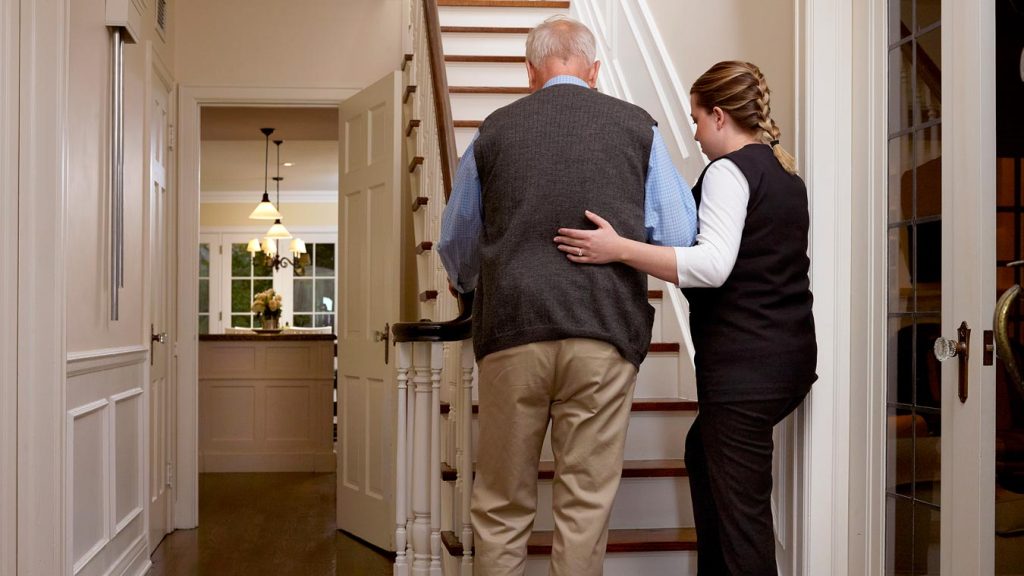Safety First: How to Prevent Falls Among Seniors

Safety First: How to Prevent Falls Among Seniors
Welcome back to our Colours Campaign, a special series about harnessing the transformative power of colour. This month, we’re embracing the sturdiness and stability of BROWN – the perfect colour to represent our latest topic: fall prevention. November is Fall Prevention Month, and we encourage all Canadians to take action to reduce the risk of falls.
The health impacts of falls
Falls are a major health and safety issue for Canada’s seniors. Each year, one in three older adults will suffer a fall, and half of them will fall more than once, reports the Public Health Agency of Canada.
For seniors, falls are the number one cause of injury-related hospitalizations. In addition to causing minor and major injuries – including bruises, sprains, bone fractures and head injuries – falls can have lasting, life-altering effects: more than a third of older adults who experience a fall are admitted to long-term care.
Risk factors for falls
What makes seniors more likely to fall? These factors increase a person’s risk:
- Age: the risk of falls increases as we get older
- Previous falls
- Lack of physical activity
- Reduced bone and muscle strength
- Poor balance or gait problems
- Vision and/or hearing impairment
- Cognitive conditions
- Medical conditions or treatments that cause fatigue, weakness, dizziness, impaired balance or mobility problems
- Chronic foot problems
- Poor nutrition or skipping meals
- Getting up at night to use the bathroom
- Excessive alcohol intake
- Living alone
- Footwear and clothing that interfere with movement
- Unsafe conditions inside or outside the home, including ice and snow
- Not using ambulatory aids such as walkers or canes when needed
- Not using safety aids such as glasses or hearing aids when needed
- Lack of safety and mobility aids, such as grab bars and railings
Preventing falls
Falls are preventable, and there are many things that older adults and their families can do to minimize the risk. Here are several ways for seniors to improve their safety:
- Maintain or improve muscle strength and bone health
- Maintain or improve range of motion and balance (through exercise and physiotherapy)
- Manage any medical conditions, such as diabetes or heart disease
- Have annual eye checkups to detect vision problems, such as glaucoma or macular degeneration, and hearing tests
- Discussing medication side effects (such as drowsiness, dizziness or muscle weakness) with a physician or pharmacist
- Use safety aids and mobility aids if needed
- Eat a nutritious diet to maintain optimal health and vitality
- Get sufficient sleep each night to prevent fatigue
- Wear supportive, well-fitting footwear with non-slip soles at all times
- Avoid wearing loose-fitting, long clothing that could cause tripping or interfere with mobility
- Get up slowly, get your balance and then walk slowly
- Avoiding rushing and hasty movements
- Avoiding carrying too many objects or heavy objects that could compromise balance
In addition, most seniors’ falls occur in their own homes, so it’s important to identify and remove any hazards both inside and outside the home, including
- Tripping hazards such as rugs, cords, furniture and pets
- Slippery or uneven floors, hallways or walkways
- Poor lighting in hallways, stairs or entrances
- Clutter
- General disrepair
- Reaching for objects on high shelves or in cabinets
The list below is a good starting point for improving home safety:
- Remove tripping hazards and clutter anywhere people walk
- Ensure there is good lighting around the home, including bathrooms, hallways and stairs
- Install railings along stairs (even for short flights), and consider adding railings to hallways
- Install grab bars in bathtubs and showers and beside toilets
- Get a shower bench or chair, and install a raised toilet seat
- Place a non-slip rubber mat in the tub
- Move frequently used items to easy-to-reach locations that don’t require climbing or stepping up
- Repair broken steps, walkways, pavement, etc.
- Use lights or contrasting paint along outdoor walkways and steps for better nighttime visibility
- Keep entrances and walkways clear of snow and ice
For more guidance and support, consider consulting an occupational therapist, who can assess the safety of your home or your senior loved one’s home. An occupational therapist will also help you address any safety issues, as well as recommend safety aids and assistive devices that can improve mobility and independence.
Additional resources
Fall prevention at home: Canada Safety Council
Home safety for seniors: Bayshore HealthCare
Bone health: Osteoporosis Canada
Healthy eating: Canada’s Food Guide
Fitness: Canadian Physical Activity Guidelines
